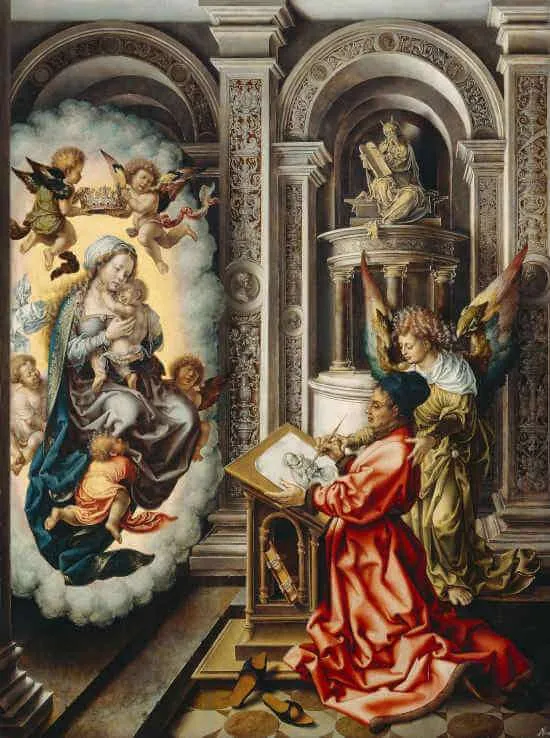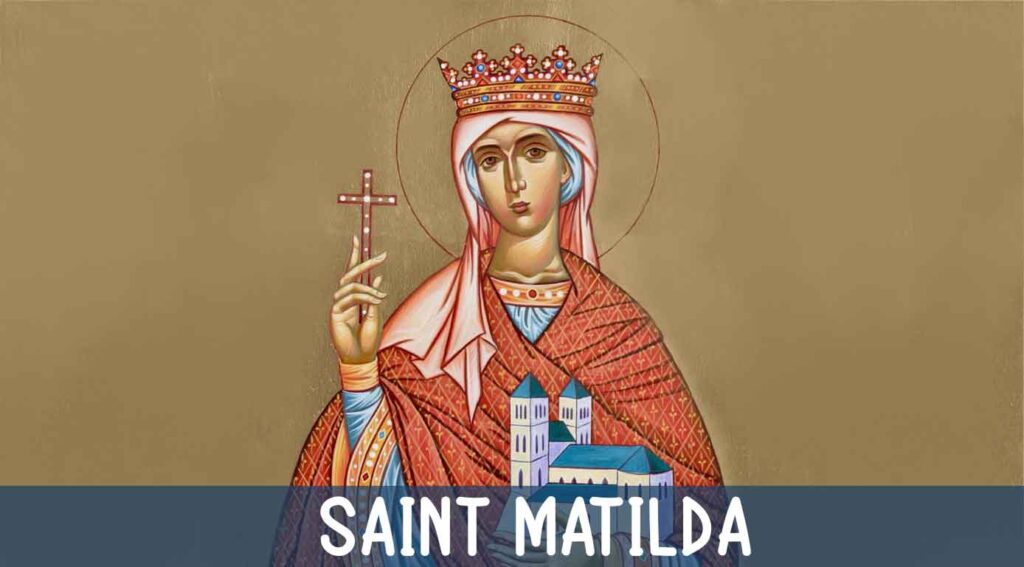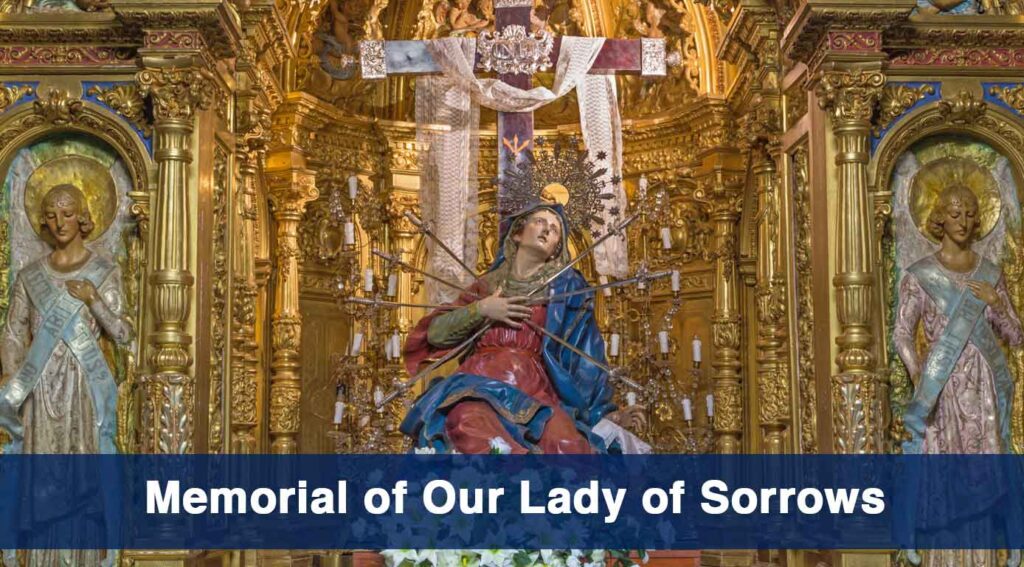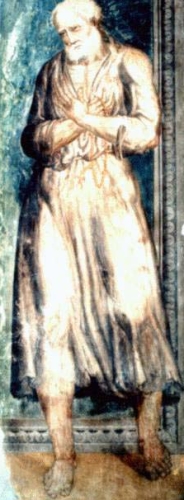First Century, died c. age 84; Patron Saint of artists, bachelors, bookbinders, brewers, butchers, glassworkers, goldworkers, laceworkers, notaries, physicians, and surgeons; Pre-Congregation canonization
In the first century, the city of Antioch was the capital of the Roman province of Syria and one of the most important cities in the eastern Mediterranean. For centuries, its ancient remains could be found in Antakya, Turkey, until a February 2023 earthquake obliterated many treasured religious sites. In the first century, Antioch was a central trade route in the Roman Empire, a culturally diverse city, mostly Greek-speaking, and an intellectual hub with a massive library. Antioch was also one of the earliest Christian communities, initially evangelized by Saints Paul and Barnabas, and whose first bishop was Saint Peter, “and it was in Antioch that the disciples were first called Christians” (Acts 11:26). Today’s exceptionally important saint, Saint Luke the Evangelist, was most likely born, raised, and discovered the faith in this city.
Luke is credited with writing the Gospel of Saint Luke and the Acts of the Apostles. According to the fourth-century historian, Eusebius, Luke “was of Antiochian parentage and a physician by profession, and…was especially intimate with Paul and well acquainted with the rest of the apostles” (3.4). Saint Paul identifies Luke in several of his epistles as being his close companion and as a physician (see Colossians 4:14; Philemon 1:24; 2 Timothy 4:11).
The fact that Luke was a faithful companion of Saint Paul is also revealed in the Acts of the Apostles when the narrative of Saint Paul’s journeys moves to the first-person plural, to “we,” implying Luke is part of the missionary activity he describes. The “we” passages begin in Acts 16:10–17 when Saint Paul receives a vision to go to Macedonia while in Troas. It appears that from this trip onward, Luke accompanied Saint Paul. The travels included Macedonia and Greece, Antioch, Galatia, Phrygia, Ephesus, back through Macedonia and Greece, and to Jerusalem, where Saint Paul was arrested and sent to Rome, spending two years there before being executed. It appears from Saint Paul’s writings that Saint Luke remained with him until the end—“Try to join me soon, for Demas, enamored of the present world, deserted me and went to Thessalonica, Crescens to Galatia, and Titus to Dalmatia. Luke is the only one with me. Get Mark and bring him with you, for he is helpful to me in the ministry” (2 Timothy 4:9–11). The second letter to Timothy was most likely written just before Saint Paul was executed.
Based on the prologue of his own Gospel, Luke was not an eyewitness to Jesus’ ministry from the beginning; rather, he accurately investigated everything anew and wrote down his findings in an orderly sequence (see Luke 1:1–4). Saint Paul mentions Mark, the author of the first Gospel, next to Luke in his epistles, clearly indicating that Mark and Luke knew each other well. Luke’s Gospel was written after Mark’s, suggesting that Luke used Mark’s Gospel as a source.
Most scholars believe that Luke was a Gentile convert. This conviction is largely based on Colossians 4:10–14, in which Saint Paul does not include Luke in his greetings by those “who are of the circumcision,” meaning those who are Jews. He includes Luke after that in the grouping of the Gentiles. Furthermore, Luke’s Gospel and the Acts give special attention to the Gentile converts, holding them in an important position. Thus, Luke was most likely the only one of the four Gospel writers who was not of Jewish origin. This is further evidenced by the fact that Luke’s Gospel appears to have been written in Greek. His Greek grammar and structure are excellent, suggesting he is well educated in Greek language, literature, and culture.
Luke’s Gospel and the Acts of the Apostles make up a two-volume single work. Both are written for a man named “Theophilus.” In the prologue to the Gospel we read, “I too have decided, after investigating everything accurately anew, to write it down in an orderly sequence for you, most excellent Theophilus…” (Luke 1:4). In the prologue to Acts we read, “In the first book, Theophilus, I dealt with all that Jesus did and taught until the day he was taken up…” (Acts 1:1–2). Scholars have varying opinions about who Theophilus is. He might be Saint Paul’s lawyer, and Luke’s writings might have been created for Saint Paul’s defense before the Roman authorities. Theophilus might also be a wealthy benefactor who commissioned and paid for Luke’s written accounts. However, many have suggested a spiritual interpretation rather than a literal one. The name “Theophilus” can mean “Friend of God.” Thus, Luke could be writing broadly to everyone who is a friend of God.
The Gospel according to Luke, the longest of the four gospels, is sophisticated in its literary form and offers a depth of moral teaching. Luke includes a number of parables and events that are not included in the other Gospels. The events include: Annunciation to Zechariah (Luke 1:5–25); Annunciation to the Blessed Virgin Mary (Luke 1:26–38); Visitation of Mary to Elizabeth and the Magnificat (Luke 1:39–56); Birth of John the Baptist with Zechariah’s Canticle (Luke 1:57–80); Presentation of Jesus in the Temple (Luke 2:22–38); Jesus at the age of Twelve in the Temple (Luke 2:41–52); Jesus’ Rejection at Nazareth (Luke 4:16–30); The Widow at Nain (Luke 7:11–17); A Sinful Woman Forgiven (Luke 7:36–50); Jesus Sends Out Seventy-two Disciples (Luke 10:1–24); Jesus visits the home of Martha and Mary (Luke 10:38–42); and Zacchaeus the Tax Collector Climbs a Tree (Luke 19:1–10).
Additionally, there are several parables only found in Luke: Good Samaritan (Luke 10:25–37); Friend at Midnight (Luke 11:5–13); Rich Fool (Luke 12:13–21); Barren Fig Tree (Luke 13:6–9); Lost Sheep (Luke 15:3–7); Lost Coin (Luke 15:8–10); Prodigal Son (Luke 15:11–32); Unjust Steward (Luke 16:1–13); Rich Man and Lazarus (Luke 16:19–31); Unjust Judge (Luke 18:1–8); Pharisee and Tax Collector (Luke 18:9–14); and Ten Coins and Servants (Luke 19:11–27).
It should be noted that only Luke includes details from the life of our Blessed Mother. Her Magnificat, experience at the Annunciation, and Presentation in the Temple suggest he either had an intimate knowledge of these events directly from the Blessed Mother or was privileged to receive a reliable and detailed account of them from another source. There is also an ancient tradition that Saint Luke was an artist who painted the first icon of the Blessed Virgin Mary with the Child Jesus.
Early tradition states that Saint Luke died at the age of eighty-four in Boeotia, Greece. It is also an ancient belief that he died a martyr, though records are unreliable. His writings, however, are reliable. Together, the Gospel of Saint Luke and the Acts of the Apostles make up a significant portion of the New Testament. God clearly used this intelligent and well-educated man when the Holy Spirit inspired Luke to write a thorough, definitive, and orderly account of God’s life-saving actions in the Person of Jesus Christ and the early Church. Saint Luke did the writing, but the Holy Spirit guided the pen, using Saint Luke’s human experience and talent as the instrument.
As we honor this great evangelist, ponder the fact that while he wrote down this orderly account of the life of Christ and the early Church, little did Luke know that his writings would be among the most widely distributed writings in the history of the world and would be one of the primary instruments of the salvation of countless souls.
Source: https://mycatholic.life/saints/saints-of-the-liturgical-year/october-18–st-luke/







